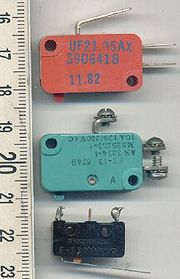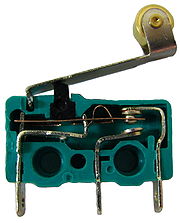
Micro switch
Encyclopedia

Tipping point (physics)
A tipping point is the point at which an object is displaced from a state of stable equilibrium into a new equilibrium state qualitatively dissimilar from the first.- In electric power :...
, sometimes called an "over-center" mechanism. Switching happens reliably at specific and repeatable positions of the actuator, which is not necessarily true of other mechanisms. They are very common due to their low cost and durability, greater than 1 million cycles and up to 10 million cycles for heavy duty models. This durability is a natural consequence of the design.
The defining feature of micro switches is that a relatively small movement at the actuator button produces a relatively large movement at the electrical contacts, which occurs at high speed (regardless of the speed of actuation). Most successful designs also exhibit hysteresis
Hysteresis
Hysteresis is the dependence of a system not just on its current environment but also on its past. This dependence arises because the system can be in more than one internal state. To predict its future evolution, either its internal state or its history must be known. If a given input alternately...
, meaning that a small reversal of the actuator is insufficient to reverse the contacts; there must be a significant movement in the opposite direction. Both of these characteristics help to achieve a clean and reliable interruption to the switched circuit.
History
The first micro switch was invented by Peter McGall in 1932 in Freeport, IllinoisFreeport, Illinois
Freeport is a city in and the county seat of Stephenson County, Illinois, United States. The population was 26,443 at the 2000 census. The mayor of Freeport is George W...
. McGall was an employee of the Burgess Battery Company at the time. In 1937 he started the company MICRO SWITCH. The company and the Micro Switch trademark has been owned by Honeywell Sensing and Control since 1950. The trademark has become a widely used description for snap-action switches. Companies other than Honeywell now manufacture miniature snap-action switches.
Construction and operation

A long flat spring is hinged at one end of the switch (the left, in the photograph) and has electrical contacts on the other. A small curved spring, preloaded (i.e. compressed during assembly) so it attempts to extend itself (at the top, just right of center in the photo), is connected between the flat spring near the contacts. A fulcrum is near the midpoint of the flat spring. An actuator nub presses on the flat spring near its hinge point.
Because the flat spring is anchored and strong in tension the curved spring cannot move it to the right. The curved spring presses, or pulls, the flat spring upward, that is away, from the anchor point. Owing to the geometry, the upward force is proportional to the displacement which decreases as the flat spring moves downward. (Actually, the force is proportional to the sine of the angle, which is approximately proportional to the angle for small angles.)
As the actuator depresses it flexes the flat spring while the curved spring keeps the electrical contacts touching. When the flat spring is flexed enough it will provide sufficient force to compress the curved spring and the contacts will begin to move.
As the flat spring moves downward the upward force of the curved spring reduces causing the motion to accelerate even in the absence of further motion of the actuator until the flat spring impacts the normally-open contact. Even though the flat spring unflexes as it moves downward, the switch is designed so the net effect is acceleration. This "over-center" action produces a very distinctive clicking sound and a very crisp feel.
In the actuated position the curved spring provides some upward force. If the actuator is released this will move the flat spring upward. As the flat spring moves, the force from the curved spring increases. This results in acceleration until the normally-closed contacts are hit. Just as in the downward direction, the switch is designed so that the curved spring is strong enough to move the contacts, even if the flat spring must flex, because the actuator does not move during the changeover.
Applications
Common applications of micro switches include the door interlockInterlock (engineering)
Interlocking is a method of preventing undesired states in a state machine, which in a general sense can include any electrical, electronic, or mechanical device or system....
on a microwave oven
Microwave oven
A microwave oven is a kitchen appliance that heats food by dielectric heating, using microwave radiation to heat polarized molecules within the food...
, levelling and safety switches in elevator
Elevator
An elevator is a type of vertical transport equipment that efficiently moves people or goods between floors of a building, vessel or other structures...
s, vending machine
Vending machine
A vending machine is a machine which dispenses items such as snacks, beverages, alcohol, cigarettes, lottery tickets, consumer products and even gold and gems to customers automatically, after the customer inserts currency or credit into the machine....
s, and to detect paper jams or other faults in photocopiers. Micro switches are commonly used in tamper switches on gate valves on fire sprinkler systems and other water pipe systems, where it is necessary to know if a valve has been opened or shut.
Micro switches are very widely used; among their applications are appliances, machinery, industrial controls, vehicles, and many other places for control of electrical circuits. They are usually rated to carry current in control circuits only, although some switches can be directly used to control small motors, solenoids, lamps, or other devices. Special low-force versions can sense coins in vending machines, or with a vane attached, air flow. Micro switches may be directly operated by a mechanism, or may be packaged as part of a pressure, flow, or temperature switch, operated by a sensing mechanism such as a Bourdon tube. In these latter applications, the repeatability of the actuator position when switching happens is essential for long-term accuracy. A motor driven cam (usually relatively slow-speed) and one or more micro switches form a timer mechanism. The snap-switch mechanism can be enclosed in a metal housing including actuating levers, plungers or rollers, forming a limit switch useful for control of machine tools or electrically-driven machinery.

